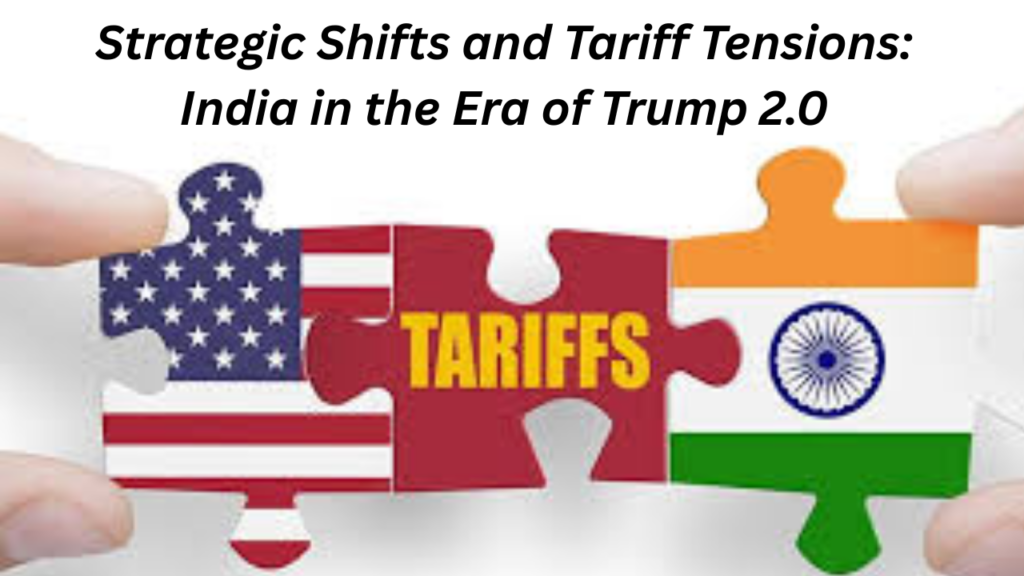
Introduction
The return of Donald Trump to the White House in 2025 has once again highlighted a significant shift in U.S. foreign economic policy. Emphasizing a “transactional” approach, this administration is marked by aggressive use of tariffs, bilateralism, and a protectionist stance. Unlike earlier multilateral strategies, Trump’s renewed diplomacy treats trade as a tool of pressure, targeting both adversaries and strategic allies.
India, as a rising economic power and significant U.S. partner, finds itself at the crossroads of this realignment. Trump’s second-term tariff measures, while aimed at correcting trade imbalances, have disrupted established trade routes and agreements. This blog explores how India is navigating this evolving terrain through strategic diversification, assertive diplomacy, and internal policy recalibration.
Tariff Diplomacy: The New Normal
Trump’s 2025 administration has expanded the use of tariffs to sectors vital to India, including aluminum, pharmaceuticals, and IT hardware. Unlike the initial tenure, this phase of economic nationalism has widened in scope, affecting not just adversaries like China, but key partners like India. The imposition of these tariffs has caused delays in trade contracts, reduced Indian exports in select sectors, and heightened business uncertainty.
The administration’s view is clear: trade relationships must deliver immediate economic gain for the U.S., often through the lens of domestic political interests. As a result, global trade partners, especially middle powers like India, must recalibrate their approach to safeguard long-term interests.
India’s Strategic Response
India has not remained passive in this shifting environment. Its response is multi-pronged:
Trade Diversification: India is accelerating negotiations with the European Union, Australia, and ASEAN. Talks with the UK for a free trade agreement have also gained momentum. These moves are intended to reduce dependence on the unpredictable U.S. market and broaden India’s trade landscape.
Multilateral Engagement: At forums like the WTO, India has become more assertive, voicing concerns over unilateral tariff measures and the erosion of global trade norms. This reflects India’s commitment to a rules-based order even while adapting to changing power dynamics.
Domestic Economic Realignment: Policy initiatives like Make in India, Digital India, and Aatmanirbhar Bharat have gained renewed relevance. The government is pushing for value-added exports, resilient supply chains, and incentives for local manufacturing to buffer against external shocks.
Diplomatic Realignments and Geopolitical Implications
The transactional shift in U.S. policy has also influenced India’s diplomatic engagements:
Strategic Autonomy: India has intensified partnerships with middle powers and revived South-South cooperation frameworks. By not fully aligning with any single bloc, India maintains its independence while maximizing economic opportunities.
Balancing China and the U.S.: The recalibration includes a more balanced posture toward China. While maintaining its security concerns, India recognizes the necessity of economic pragmatism in regional cooperation, especially with regard to supply chains and regional connectivity.
Impact on Key Sectors
Several sectors have borne the brunt of the new tariffs:
Aluminum & Steel: Duties led to an estimated 8% decline in exports to the U.S. in Q1 2025. This prompted Indian manufacturers to explore Southeast Asian markets.
Pharmaceuticals: Indian generics have faced delays due to new compliance standards and tariff pressures, impacting bilateral health cooperation.
IT Hardware: New tariffs on components have slowed hardware exports, although India is using this moment to invest in domestic electronics manufacturing.
These shocks have underlined the vulnerabilities of overdependence and emphasized the need for strategic hedging.
India’s Role in WTO and Global Norm-Building
India’s growing assertiveness at the World Trade Organization is noteworthy. It has challenged unilateral trade actions and pushed for reforms that restore balance and predictability. India’s stance aligns with other developing nations calling for non-discriminatory rules and resisting protectionism.
This advocacy positions India as a voice for the Global South and highlights its emergence as a rule-shaping actor rather than a rule-taker.
Lessons and Recommendations
India’s handling of the second wave of U.S. tariff diplomacy offers valuable insights:
Resilience through Diversification: India must deepen ties with emerging markets in Africa, Latin America, and Southeast Asia. Diversifying export destinations cushions against policy shocks from major partners.
Boosting Competitiveness: Investment in logistics, standards compliance, and digital infrastructure can help Indian goods remain competitive despite tariff disadvantages.
Strengthening Regional Trade Architecture: Re-engaging with regional groupings like RCEP or developing Indo-Pacific trade frameworks could boost India’s strategic depth.
Domestic Capacity Building: Reducing reliance on imported technology and improving domestic manufacturing will be critical for long-term self-reliance.
Leveraging Multilateral Forums: India should continue to align with coalitions that support fair trade, transparency, and sustainable development.
Conclusion
Trump’s second-term tariff policies have reaffirmed the age of transactional diplomacy. While such moves challenge the multilateral trade regime, they also push countries like India to act with greater strategic clarity. India’s response—marked by diversification, diplomatic assertiveness, and internal reform—demonstrates its evolving maturity as a global economic player.
In navigating this uncertain era, India is not merely reacting but reshaping its global footprint with resilience and foresight. As the international trade order becomes increasingly interest-driven, India’s balanced and forward-looking approach can serve as a model for other emerging economies seeking autonomy amid great power competition.
Sources
Brookings Institution. (2025). The new trade order
Peterson Institute for International Economics. (2025). Trump 2.0 Policy Brief
Observer Research Foundation. (2025)
Ministry of Commerce & Industry, GoI
WTO Watch. (2025)
Foreign Affairs, CFR, IDSA
